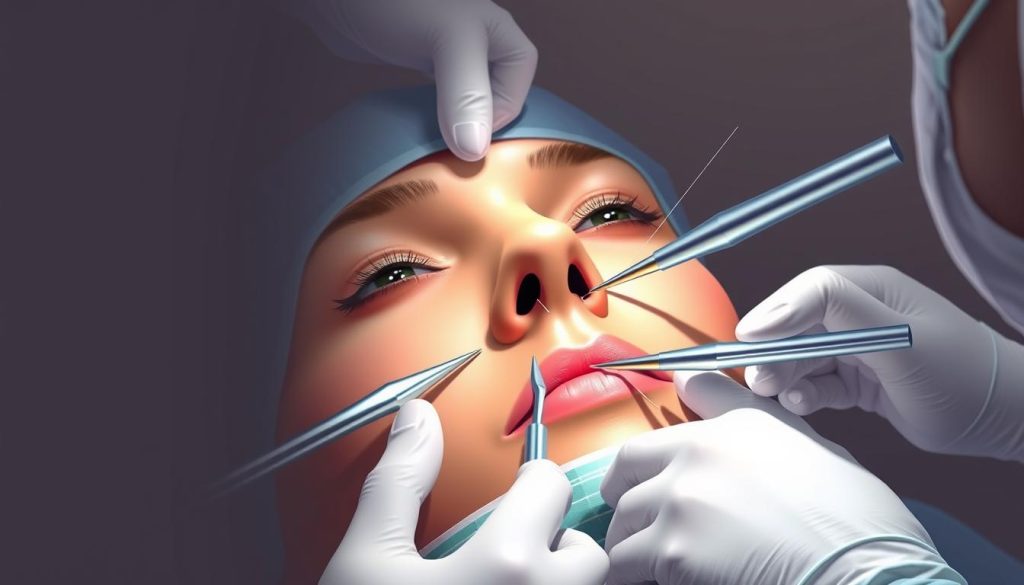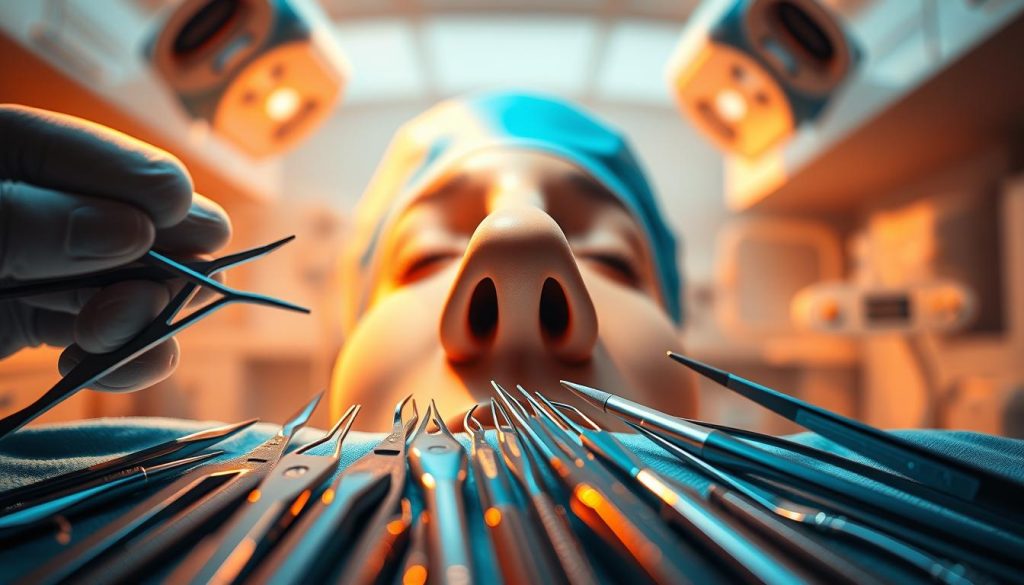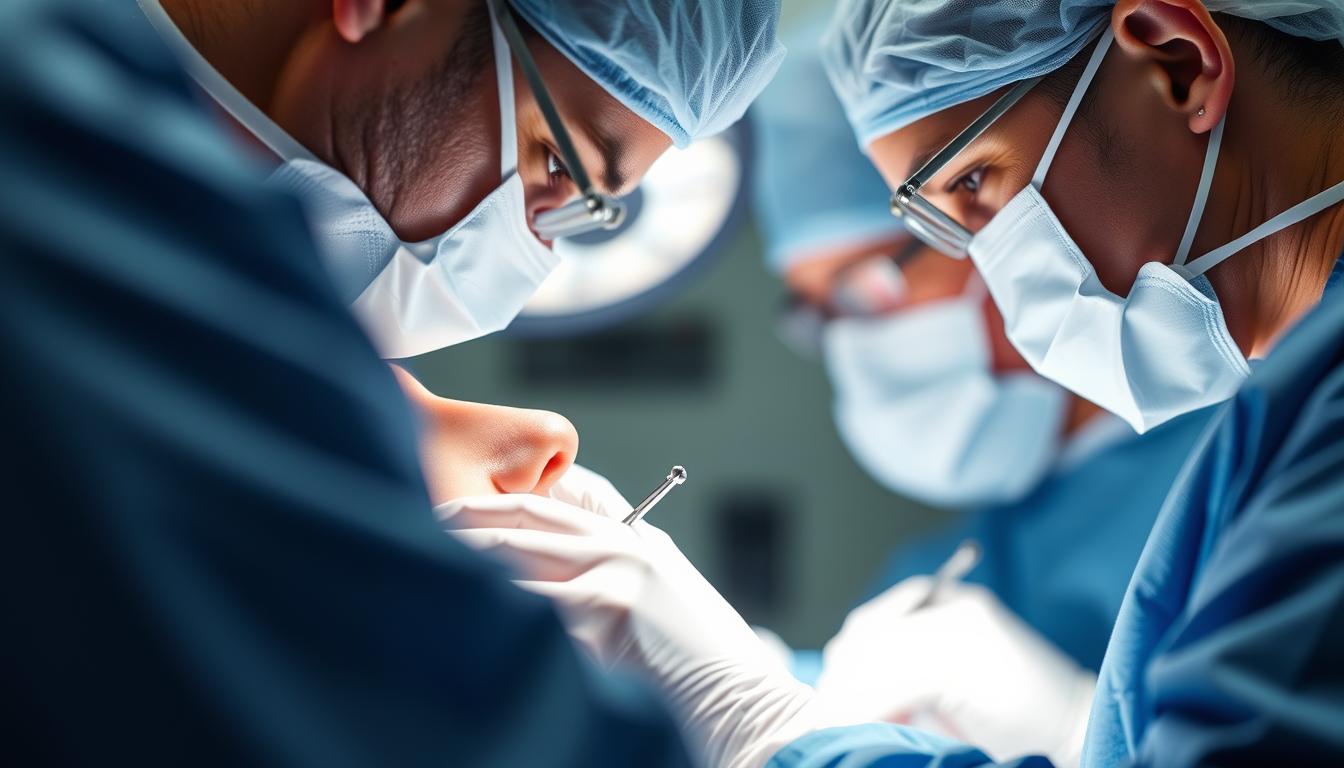Rhinoplasty, commonly referred to as a “nose job,” is a sophisticated surgical procedure designed to enhance the appearance and function of the nose.
By reshaping the nasal structures, including bone, cartilage, and skin, a cosmetic surgeon can help achieve various improvements, addressing both aesthetic concerns and functional issues.
Understanding the fundamentals of rhinoplasty helps patients set realistic expectations and achieve better results from their surgery. Modern techniques focus on creating natural-looking results that complement the patient’s unique facial structure.
Key Takeaways
- Rhinoplasty enhances facial harmony and corrects impaired breathing caused by structural defects.
- The procedure can dramatically improve facial harmony by bringing the nose into better proportion.
- Advances in surgical techniques have made nose reshaping safer and more effective.
- Patients should undergo thorough research and consultation with qualified professionals.
- Understanding rhinoplasty fundamentals helps patients achieve better results.
What is Nose Esthetic Surgery?

The nose esthetic surgery procedure, commonly referred to as rhinoplasty, is designed to modify the shape, size, and structure of the nose to improve both its appearance and function. This surgical intervention is tailored to address a variety of concerns, ranging from aesthetic issues to functional problems that affect breathing.
Common Aesthetic Concerns Addressed
Nose esthetic surgery can address a wide range of aesthetic concerns, including bumps on the bridge, bulbous tips, asymmetry, and disproportionate size relative to other facial features. Common aesthetic modifications include reducing a prominent dorsal hump, refining a bulbous nasal tip, narrowing wide nostrils, and correcting asymmetries.
Functional Improvements for Breathing
Beyond cosmetic improvements, rhinoplasty often addresses functional issues that affect breathing and quality of life. Functional improvements typically focus on correcting a deviated nasal septum, which is the wall dividing the nasal passages that can become crooked and obstruct airflow. Surgeons may also repair internal nasal valve collapse or reduce enlarged turbinates to improve breathing function.
Benefits of Nose Esthetic Surgery
The benefits of nose esthetic surgery are multifaceted, ranging from aesthetic improvements to functional enhancements. Rhinoplasty can significantly impact a patient’s quality of life by addressing various concerns related to the nose.
Enhancing Facial Harmony and Balance
One of the primary benefits of rhinoplasty is the enhancement of facial harmony and balance. By improving the shape and proportion of the nose, the overall balance and symmetry of the face can be achieved. This is particularly beneficial for individuals who feel that their nose is disproportionate to their other facial features.
Correcting Structural Defects
Rhinoplasty can also correct structural defects in the nose, such as a deviated septum, which can improve breathing and overall nasal function. By making changes to the underlying bone and cartilage structure, rhinoplasty can produce lasting results while maintaining natural nasal function.
| Benefits | Description |
|---|---|
| Enhances Facial Balance | Improves the overall balance and symmetry of the face by adjusting the nose proportion. |
| Corrects Structural Defects | Addresses issues like deviated septum, improving breathing and nasal function. |
| Improves Appearance | Corrects aesthetic issues with the nose, such as bumps or bulbous tips. |
As noted by a renowned plastic surgeon, “Rhinoplasty is not just about changing the appearance of the nose; it’s also about improving its function and ensuring that it works in harmony with other facial features.” This highlights the comprehensive nature of nose esthetic surgery.
The Nose Esthetic Surgery Procedure

The rhinoplasty procedure is a multi-stage process that includes consultation, surgery, and post-operative care. This comprehensive approach ensures that patients achieve the desired outcomes while minimizing potential risks.
Pre-Surgery Consultation and Planning
During the pre-surgery consultation, the surgeon evaluates the patient’s nasal structure and discusses their aesthetic goals. The surgeon reviews the patient’s medical history and creates a customized surgical plan using advanced imaging techniques.
Patients are advised to bring a list of their current medications and supplements, along with photographs of their desired nose shape, to facilitate clear communication with their surgeon.
During the Surgery: What to Expect
The rhinoplasty procedure typically takes between one and three hours and is performed under general anesthesia or local anesthesia with intravenous sedation. The surgeon makes either internal incisions (closed rhinoplasty) or an additional small incision across the columella (open rhinoplasty).
The surgeon then modifies the nasal framework by reshaping cartilage and bone, sometimes adding cartilage grafts to achieve the desired structural changes.
Immediate Post-Operative Care
After the surgery, a small plastic splint is placed to minimize swelling and maintain the nose’s new shape. Patients may also have nasal packing, which is typically removed within 24-48 hours.
Patients receive detailed instructions for at-home care, including medication management and activity restrictions, to optimize healing and results.
Types of Rhinoplasty Techniques
Rhinoplasty techniques have evolved significantly, offering patients a range of options tailored to their specific needs. The choice of technique depends on the individual’s nasal anatomy and aesthetic goals.
Open vs. Closed Rhinoplasty
Open rhinoplasty involves a small external incision between the nostrils, providing the surgeon with greater visibility and access to the nasal structures. In contrast, closed rhinoplasty uses internal incisions, eliminating visible scarring and potentially reducing swelling and recovery time.
Tiplasty and Specialized Approaches
Tiplasty is a specialized technique focusing on reshaping the nasal tip without altering other nasal structures. Other specialized approaches include preservation rhinoplasty, ethnic rhinoplasty, and revision rhinoplasty, each addressing specific needs and concerns.
Non-Surgical Rhinoplasty Options
Non-surgical rhinoplasty uses injectable fillers to camouflage bumps, improve symmetry, or refine the nasal tip. While these procedures offer immediate results with minimal downtime, their effects are temporary, lasting 6-12 months.

Recovery Timeline and Managing Expectations
Understanding the recovery timeline is essential for patients undergoing rhinoplasty. The process involves several stages, and being informed helps manage expectations.
Week-by-Week Healing Process
The recovery timeline following nose esthetic surgery follows a predictable pattern, though individual healing experiences may vary. The first week is characterized by moderate discomfort, facial swelling, and bruising around the eyes. By weeks 2-3, most visible bruising subsides, though swelling remains. Weeks 4-6 mark significant improvement as approximately 60-70% of swelling resolves.
| Week | Healing Stage | Characteristics |
|---|---|---|
| 1 | Initial Recovery | Moderate discomfort, swelling, bruising, nasal splint |
| 2-3 | Improvement | Bruising subsides, swelling remains, return to light activities |
| 4-6 | Significant Improvement | 60-70% swelling resolved, nose takes new shape, improved breathing |
Managing Swelling and Asymmetrical Healing
Swelling is a natural part of the healing process after rhinoplasty. It can lead to asymmetrical healing, where one side of the nose is more swollen than the other, creating a temporary appearance of crookedness. Patients should follow their surgeon’s post-operative instructions to minimize complications and ensure optimal healing.

Choosing the Right Surgeon for Optimal Results

A well-performed rhinoplasty starts with selecting a surgeon who has a deep understanding of nasal anatomy and aesthetics. The complexity of rhinoplasty demands a specially trained cosmetic surgeon with extensive experience in facial cosmetic surgery.
When searching for a surgeon, consider the following key factors:
- Board certification in plastic surgery or facial plastic surgery is a minimum requirement.
- Look for surgeons who specialize in rhinoplasty and perform a high volume of these procedures annually.
- Review before-and-after photos of previous patients to gauge the surgeon’s aesthetic approach and technical capabilities.
- Ensure the surgeon’s facility is properly accredited with a qualified anesthesia provider and comprehensive safety protocols.
During consultations, evaluate the surgeon’s communication style, ensuring they listen to your goals and clearly explain realistic options. Personal rapport and trust between patient and surgeon are essential for a successful rhinoplasty outcome.
By choosing a qualified and experienced surgeon, you can achieve the desired results and minimize the risks associated with nose surgery or nose reshaping.
FAQ
What is the difference between open and closed rhinoplasty?
Open rhinoplasty involves an incision between the nostrils, providing a more detailed view of the nasal structure, while closed rhinoplasty involves incisions within the nostrils, resulting in less visible scarring.
How long does it take to recover from rhinoplasty?
The recovery time varies, but most patients can return to their normal activities within 1-2 weeks. However, it may take several months for the swelling to fully subside and the final results to be visible.
Will rhinoplasty improve my breathing if I have a deviated septum?
Yes, rhinoplasty can improve breathing by correcting a deviated septum and other structural issues. A surgeon will assess the nasal passage and recommend the necessary procedures to improve both the appearance and function.
Can I undergo rhinoplasty if I have had previous nasal procedures?
Yes, but it’s crucial to discuss your previous procedures with your surgeon to determine the best course of action. They will assess the condition of your nasal structure and advise on the feasibility of further rhinoplasty procedures.
What are the potential risks and complications of rhinoplasty?
As with any surgical procedure, rhinoplasty carries risks such as bleeding, infection, and adverse reactions to anesthesia. A qualified surgeon will discuss these risks and take steps to minimize them.
How do I choose the right surgeon for my rhinoplasty?
To choose the right surgeon, look for a board-certified professional with extensive experience in rhinoplasty techniques and a portfolio of successful outcomes. A thorough consultation will also help determine if the surgeon is a good fit for your needs and goals.
